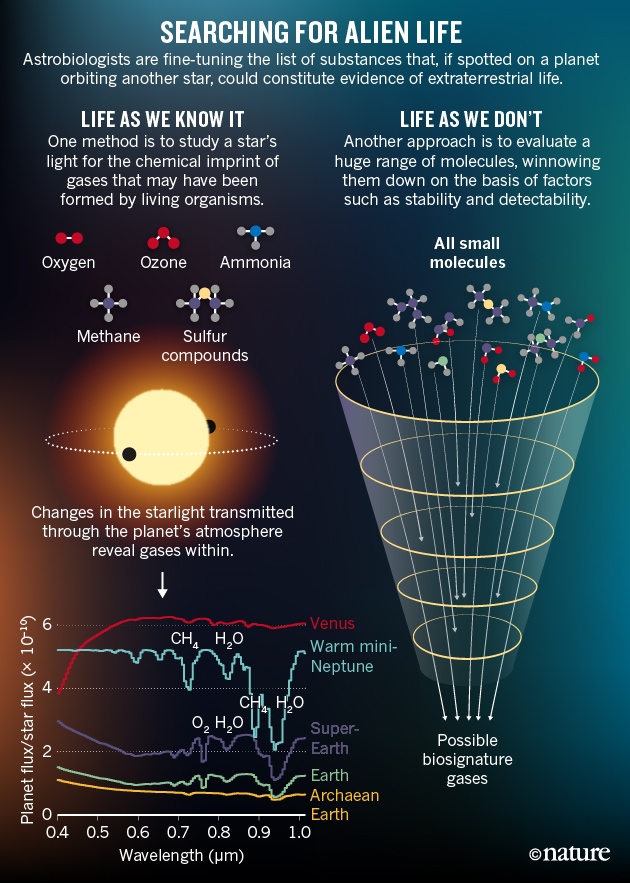The limits of life and its signatures
 The question of whether life is a freak occurrence or a frequent outcome of cosmic evolution has puzzled both astrophysicists and biologists for several decades, starting from the pioneering hypotheses on abiogenesis of Alexander Oparin in the early 20th century and the seminal experiment of Stanley Miller and Harold Urey in the 1950s. The stuff of life is abundant in the universe, as living organisms on Earth are made primarily of C, H and O, three of the most common atoms in the universe. The availability of biogenic elements in the universe (organic compounds ranging from bi-atomic molecules to complex chains and even amino acids) has been repeatedly proven by astronomical observations, not only in meteorites, comets and other bodies of our solar system but also in star forming regions and in interstellar space. Low-entropy energy is also widely available, primarily from stars but, conceivably, also in different forms such as geothermal and radiogenic energy from the cooling core of rocky planets or satellites. A crucial basic ingredient of life is the availability of an appropriate solvent, usually identified with water in the liquid phase. Thus, the search for environments that could have the right conditions for life has been mostly focused on planetary surfaces which could support the stable presence of liquid water on biological time-scales. So far, no evidence exists that life began and evolved in any place other than Earth. On the other hand, based on current knowledge, the existence of possible abodes for life beyond Earth seems plausible.
The question of whether life is a freak occurrence or a frequent outcome of cosmic evolution has puzzled both astrophysicists and biologists for several decades, starting from the pioneering hypotheses on abiogenesis of Alexander Oparin in the early 20th century and the seminal experiment of Stanley Miller and Harold Urey in the 1950s. The stuff of life is abundant in the universe, as living organisms on Earth are made primarily of C, H and O, three of the most common atoms in the universe. The availability of biogenic elements in the universe (organic compounds ranging from bi-atomic molecules to complex chains and even amino acids) has been repeatedly proven by astronomical observations, not only in meteorites, comets and other bodies of our solar system but also in star forming regions and in interstellar space. Low-entropy energy is also widely available, primarily from stars but, conceivably, also in different forms such as geothermal and radiogenic energy from the cooling core of rocky planets or satellites. A crucial basic ingredient of life is the availability of an appropriate solvent, usually identified with water in the liquid phase. Thus, the search for environments that could have the right conditions for life has been mostly focused on planetary surfaces which could support the stable presence of liquid water on biological time-scales. So far, no evidence exists that life began and evolved in any place other than Earth. On the other hand, based on current knowledge, the existence of possible abodes for life beyond Earth seems plausible.
Instrumental in assessing the possible frequency of life in the universe, and in identifying potential targets for exploration, is a better understanding of the limits of life as we know it. In the past decades we collected remarkable examples of the incredible adaptability of life on Earth to extreme environments and conditions, from dry deserts to hot springs, from ocean depths to deep space. One of the aims of current astrobiological research is conducting experiments on the survavibility of living organisms in simulated environments that can constitute an analogue of unfamiliar extraterrestrial worlds, such as Mars, the icy moons of giant planets in the Solar System, or rocky exoplanets orbiting M-dwarf stars. This research has also the parallel goal of identifying potential signatures of biological activity (or ‘biosignatures’) that can be used to infer the presence of life on other worlds from remote astronomical observations.
Related Researchers
A. Balbi, D. Billi.
Related Projects
WorkPackage A1:
- BIO-SIgnatures and habitable Niches_Cyano (ESA-ASI-funded);
- Biofilm Organisms Surfing Space_Cyano (ESA-ASI-funded);
- BIOlogy and Mars Experiment_Cyano (ESA-ASI-funded)
Workpackage A2:
- Life in Space: Origin, Presence, Persistence of life in Space -OPPS (ASI-funded)
